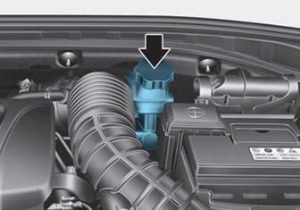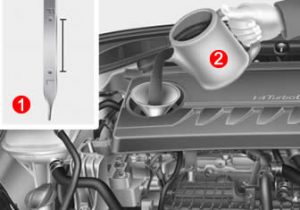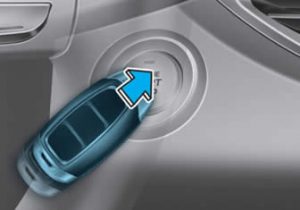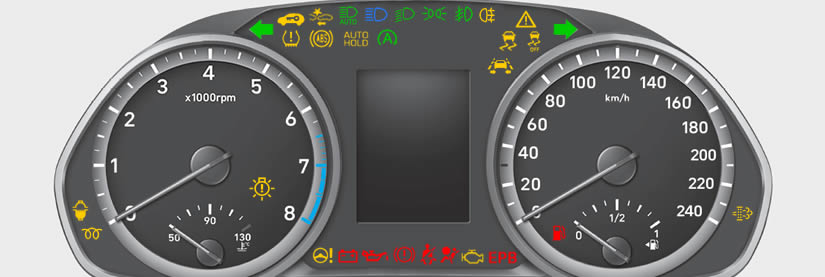Hyundai i30 Dashboard Warning Lights
The i30 has been manufactured by Hyundai since 2007 and is currently on the third generation. The Hyundai i30 dashboard warning lights detailed below cover the first generation (Mk 1 / 2007 – 2012), the second generation (Mk 2 / 2012 – 2017) and the current third generation (Mk 3 / 2017 – present).
Dashboard layout design and warning light location vary depending on the year and model of i30. Many of the warning lights have the same meaning regardless of the year or model of your Hyundai i30, though any warning lights that are generation or model specific are noted.
| Symbol | Warning Description and Action |
|---|---|
 | When the ignition or the engine start/stop button is switched to ON, the Hyundai i30 airbag warning light illuminates for approximately 6 seconds then goes off. A fault with the SRS (Supplemental Restraint System) is indicated by the light remain on. This may be a fault with the airbag or seat belt pretensioner system. Occasionally cables become loose under the passenger seat due to objects becoming lodged and pushed. Check all cables are firmly connected. |
 | When the ignition or the engine start/stop button is switched to ON, the Hyundai i30 brake warning light illuminates for approximately 3 seconds then goes off. The light remains on if the parking brake is applied. If the parking brake is fully released, it indicates that brake fluid levels are low. Low brake fluid level It's normal for brake fluid levels to fall over time as brake pads wear. 1. Find a safe place to stop and switch off the engine. 2. Check the brake fluid level in the brake fluid reservoir. On the side of the tank, the level should fall between the 'MIN' and 'MAX' marks. 3. Use only hydraulic brake fluid conforming to DOT 3 or DOT 4 specification. 4. Before removing the reservoir cap, clean the area around the cap. If debris falls into the reservoir tank, it will contaminate the fluid. 5. Add fluid ensuring you do not exceed the MAX mark. 6. Check for any leak. If the system is leaking fluid or if the warning light remains on, do not continue driving. Frequent additions of fluid may indicate a leak. Hyundai i30 brake fluid reservoir tank  Note For the first generation of the Hyundai i30, the above issue is indicated by the following warning light:  |
 | When the ignition or the engine start/stop button is switched to ON, the Hyundai i30 ABS warning light illuminates for approximately 3 seconds then goes off. If the ABS (anti-lock braking system) warning light stays on, there is a fault in the system. This is often a sensor related malfunction. ABS is an addition to normal brake and the system detects when the wheels are beginning to lock. ABS pulsates the brakes very quickly and constantly adjusts pressure to apply the most brake force possible without locking the wheels. The normal braking system will still be operational without the assistance of the anti-lock brake system. Be warned however, there is a greater possibility of the wheels locking when under emergency braking. |
 | The illumination of both the ABS and BRAKE warning lights together indicate a fault with the Electronic Brake Force Distribution (EBD). EBD is an additional braking aid that regulates brake pressure on a per-wheel basis. What to do This is potentially a dangerous situation as brakes may not work as expected during sudden braking. Avoid high speed driving and abrupt braking and make your way immediately to a Hyundai workshop. Note With the ABS and BRAKE warning light on, along with EBD failure, other systems may fail to operate. these include: • ABS (Anti-lock brakes) • EPS (Power steering) • Speedometer • Odometer • Tripmeter |
 | The Hyundai i30 EPB warning light comes on for around 3 seconds when the ignition switch of engine start/stop button are set to ON. If the warning light does not go off, there is a fault with the Electronic Parking Brake. What to do If the parking brake warning light flashes Note If there's a fault with the Electronic Stability Control (ESC) system, the EPB warning light may also illuminate. This does not indicate malfunction of the EPB. |
 | When the vehicle has come to a standstill by use of the brake pedal, Auto Hold keeps the vehicle stationary even though the brake pedal is not pressed. The Hyundai i30 Auto Hold warning light illuminates for the following reasons: • White: When you activate the auto hold system by pressing the AUTO HOLD button. • Green: The vehicle has come to a complete stop by use of the brake pedal with the auto hold system activated. • Yellow: A fault has been detected with the Auto Hold system. Be cautious as the vehicle may roll. Contact a Hyundai workshop. |
 | The Hyundai i30 electric power steering warning light comes on for around 3 seconds when the ignition switch of engine start/stop button are set to ON. If the warning light does not go off, there is a fault with the electric power steering. You will probably notice that without the aid of power assisted steering, turning the wheel will become harder, most noticeably at slower speeds. This isn't a critical issue but should be fixed as soon as possible. |
 | When the ignition or the engine start/stop button is switched to ON, the Hyundai i30 Malfunction Indicator Lamp (MIL) illuminates for approximately 3 seconds then goes off. If the MIL warning light stays on, there is a fault in the emission control system. Note Often referred to as the check engine light, continual driving with the MIL illuminated may damage the emission control system and lead to poor driving and economy. Petrol engines If your Hyundai i30 has a petrol engine and the MIL remains on, continual driving may result in unburnt fuel entering the exhaust system due to engine misfire. This can cause catalytic converter damage. The engine may also enter reduced power mode as a means to protect itself. Diesel engines If the MIL flashes, an error related to the injection quantity adjustment may have occurred which could result in loss of engine power, combustion noise and poor emissions. |
 | The Hyundai i30 engine coolant temperature warning light illuminates when the temperature of the coolant is above 125±2.5°C (257±4.5°F). An audible alert also sounds 5 times. If the engine overheats, you may experience a loss of power, or hear loud pinging or knocking sound. If this happens, you should: 1. Pull off the road as soon as possible. 2. Secure the vehicle by selecting neutral (manual gearbox) or 'P' (automatic gearbox) and apply the parking brake. If the air conditioning is on, switch it off. 3. If steam or coolant is coming from the engine compartment, wait until it subsides before opening the bonnet / hood. If no steam or coolant is present, keep the engine running, open the bonnet and check the cooling fan is operational. If it isn't, switch off the engine. 4. With the engine off, check the water pump drive belt is missing. If it's not missing, check that it's tight. 5. Check around the radiator for leaks and under hoses. Do not continue driving if the water pump belt is missing or if coolant is leaking from the engine. 6. If all seems satisfactory, wait for the engine to cool and top up with coolant. Keep alert for the warning light to come back on again. Continued driving when the engine is overheating can cause serious damage. Note The engine coolant temperature warning light is not on all versions of the Hyundai i30. |
 | The Hyundai i30 battery warning light illuminates in red to indicate a malfunction in the charging system. There may be a fault with the: • Battery • Alternator / generator • Alternator / generator belt • Battery connections / wiring If the battery is not being charged, it's probably that the engine may cut out when the battery has lost charge. It's advised to stop at your closest repair workshop. To conserve battery charge, switch of any electrical consumers that are non-essential. |
 | The Hyundai i30 oil warning light illuminates in red to indicate low oil pressure. If oil pressure is low, engine lubrication may be interrupted resulting in significant engine damage. In this situation: • As soon as safely possible, pull off the road and stop the engine. • Using the dipstick • Check to see if the warning light has gone out. • If you did not add oil or if the warning light remains on after adding oil, do not continue driving. Contact a Hyundai workshop. Adding engine oil  |
 | The Hyundai i30 low fuel warning light illuminates when the tank is nearly empty. Allowing the tank to become below the '0' level can result in engine misfire which can cause catalytic converter damage. |
 | The triangle containing an exclamation mart is the Hyundai i30 master warning light. The warning triangle illuminates along with a message for the following reasons: • Low washer fluid. • Smart high beam malfunction. • Blind Spot Detection (BSD) malfunction. • Autonomous Emergency Braking (AEB) malfunction. • Speed Limit Information Function (SLIF) malfunction. • Advanced Smart Cruise Control malfunction. • Tyre Pressure Monitoring System (TPMS). The above faults are dependent on whether your i30 is equipped. |
 | The Hyundai i30 low tyre pressure warning light illuminates for the following reasons: • Warning light remains on constantly: One or more tyres have become under-inflated • Warning light flashes for 1 minute then remains on constantly: A fault has been detected with the tyre pressure monitoring system, or a tyre has been fitted without a sensor (the spare tyre for example). Resetting the Hyundai i30 tyre pressure system Inflate tyres to the recommended values as determined by the pressure label found inside the driver's door. After driving for a few minutes, the TPMS will detect the new values and the system will automatically reset and the light will go out. |
 | For diesel versions of the Hyundai i30 only, the fuel filter separates water from the fuel which accumulates in the bottom of the filter. When the filter becomes full, the Hyundai i30 fuel filter warning light illuminates. At this point, it's important to have the water drained from the filter as soon as possible. Note When the fuel filter warning light illuminates, engine power may be reduced. This is a safety procedure and is normal. Continual driving with the fuel filter warning light on may damage components such as the fuel injectors and fuel pump. These are expensive parts and such damage would unlikely to be covered by vehicle warranty. |
 | The Hyundai i30 DPF warning light comes on or flashes, the Diesel Particulate Filter either has a fault or requires cleaning. Cleaning the Hyundai i30 DPF Cleaning of the DPF is often an automatic procedure where no driver involvement is required. However, if you frequently only take short trips in your vehicle, the DPF may require cleaning more often and may require driver involvement which is indicated by the warning light illuminating. To initiate and clean the filter: • Drive at more than 37 mph (60 km/h); or • Keep the engine speed (RPM) at between 1500 and 2500 rpm • For approximately 25 minutes The DPF warning light will go out once the cleaning process has completed. Note If you continue to drive with the DPF warning light on or flashing, the DPF system may become damaged (over-saturated with particulate matter). There will also be an increase in fuel consumption. |
 | For diesel versions of the Hyundai i30 only, the preheat 'glow plugs' warning light illuminates when the engine is being preheated whilst the ignition switch of engine start/stop button is set to 'on'. Once the warning light goes out, the engine can be started. The amount of time the light remains on varies depending on engine coolant temperature and air temperature (the colder, the longer it stays on) and the condition of the battery. If the engine fails to start within 10 seconds or preheating, set the ignition to OFF for 10 seconds then try again. Note If the glow plugs warning light stays on or flashes after the engine has warmed up or while driving, there may a malfunction with the engine preheating system. |
 | The Hyundai i30 Electronic Stability Control (ESC) warning light illuminates for 3 seconds when the ignition switch or engine stop/start button is set to ON and then goes out. ESC helps to stabilise the vehicle during cornering and accelerating to prevent wheel slip. When the warning light: Flashes: It indicates the system is actively attempting to stabilise the vehicle. In this situation, engine power may be reduced and/or wheel braking may occur. Comes on constant: It indicates a fault with the system. ESC uses ABS sensors and a fault is often related to this. |
 | The Hyundai i30 Blind Spot Detection system (BSD) warns when it detects an oncoming vehicle in the blind spot area. When the system is activated, it becomes operational when the vehicle speed is above about 20 mph (30 km/h). Note The detection radar is located in the rear bumper. If you have a warning message that the blind spot detection system has been disabled, ensure the bumper is clear of dirt. Bad weather may also prevent the system from functioning. |
 | The Hyundai i30 automatic engine start / stop system (Auto Stop) - ISG (Idle Stop and Go) warning light illuminates when the engine enters idle stop mode. when automatic starting occurs, the warning light flashes for 5 seconds. Note When the engine automatically starts by the ISG system, certain warning lights such as the ABS, ESC, ESC OFF, EPS or Parking brake may illuminate for a few seconds. This is due to low battery voltage and it does not mean the system has malfunctioned. If you are having issues with your Idle Stop and Go system, see Hyundai i30 start stop deactivated or not working for possible reasons. |
 | The car with a key inside it is the Hyundai i30 immobiliser warning light. The system may not recognise your key's unique code if another immobiliser key is near the key, or if and metal object is near the key as this will interrupt with the transponder signal. The immobiliser warning light illuminates for the following reasons: Without smart key: The immobiliser warning light flashes when a fault has been detected with the system. In this instance, try another key if you have one. A possible fault may be due to a damaged key, or antenna ring round the ignition. With smart key: The immobiliser warning light flashes: • When the smart key is not in the vehicle • When there is a fault with the immobiliser system. • When the battery in the smart key is almost dead. At this point, the vehicle can still be started by pressing the engine Start/Stop button with the smart key. For further information on remote key and smart key battery replacement on all models of the Hyundai i30, see Hyundai i30 key battery replacement guide. Starting the engine with a smart key  |
 | The Autonomous Emergency Braking (AEB) system monitors road traffic / pedestrians ahead via radar and camera recognition. If detected, the system warns the driver of an imminent collision. If the driver does not react satisfactorily, emergency braking may be automatically applied. If the Hyundai i30 AEB warning light illuminates while driving, it indicates a malfunction with the system. This may be due to the radar and/or camera being dirty or covered with snow. The radar plate is located on the front grill and the camera is located at the centre-top of the front windscreen - clean both locations. The system may temporarily malfunction if the camera sensor is too hot. This can happen when parking on a hot day under direct sunlight for example. |
 | The Lane Keeping Assist System (LKAS) detects lane lines on the road, and assists the driver's steering to help keep the vehicle between lanes. The Hyundai i30 Lane Keeping Assist warning light illuminates in: • Green: When LKAS operating conditions are satisfied. • White: LKAS operating conditions are not satisfied. • Yellow: A fault has been detected with LKAS. When there's a problem with LKAS, do one of the following: • Restart the engine, then turn on LKAS. • Check if the ignition switch is in the ON position. • Check if the system is affected by the bad weather. This can be due to fog, heavy rain, etc. • Ensure the camera lens located on the centre-top front windscreen is clear of dirt, snow or any other debris. |
 | This Lane Departure Warning System (LDWS) detects the road lane with sensor located at the front windscreen and warns you when your vehicle leaves the lane. The Hyundai i30 LDWS warning light illuminates in: • Green: When the lane departure warning system has been activated. • White: When LDWS operating conditions are not satisfied. • Yellow: When there is a malfunction with the LDWS. When there's a problem with LDWS, do one of the following: • Restart the engine, then turn on LDWS. • Check if the ignition switch is in the ON position. • Check if the system is affected by the bad weather. This can be due to fog, heavy rain, etc. • Ensure the camera lens located on the centre-top front windscreen is clear of dirt, snow or any other debris. |
 | The Hyundai i30 snowflake warning light is an indication that the roads may be slippery and icy. The light comes on when outside temperatures are approximately below 4°C (40°F). To warn of the hazard, the icy road warning light illuminates, the outside temperature gauge flashes and a warning signal sounds once. |

I noticed The DPF light on in my 2021 Hyundai i30 petrol car, can you explain why it is on or has it been on since I purchased the car
Hi Sean,
Particulate filters are usually associated with diesel engine and with petrol, they rarely cause issues. A drive on a main road where no stopping and starting for 20 minutes or so is usually enough to clean the filter. If the light remains on or has been on since you purchased the car, you need to have it looked at as it can result in damage.
We have a 2017 i30 auto and the ABS and the Traction Control lights have come on . Car has been sitting for about 2 mths then the lights came on when driven. Any help would be appreciated.
Hello Heather,
If your car hasn’t been used for a few months, it could be low battery charge causing the issue. A low charge can cause many electric faults. If your alternator is working as it should, the battery will regain charge after a long drive. If a long drive isn’t something you do, leaving it on charge overnight might help. It might not be that, but it’s the easiest place to start.
We have a similar issue after car been standing for around 6 months being driven on off but stood mostly.
My 2011 Hyundai keep stalling when Im at lights, Hyundai servicemen cant find any faults with it what else could be causing this issue, the dash light of a car comes on every time it does this
I’m having this issue too. Did you find out what it was?
On my dashboard the A light is illuminated which is the stop start, I also noticed a strong smell, is the car still safe to drive?
Hi Sarah,
Is your i30 a diesel? If it is, I would at a guess it’s perhaps the DPF (diesel particulate filter) being regenerated. This will cause the start stop to be temporarily disabled and you may notice an unpleasant smell. If it continues, I should have it checked out.
Hi
Please can you tell me if the i30, 2017 model, has a warning light for the window being left open?
Thank you
Hi Tony,
There is a sunroof warning (engine off), but no windows open warning that I’m aware of on the i30.
My Hyundai has the blue dashboard light on and won’t go off, even when key is out of ignition. It has drained my battery overnight but I don’t know how to get it to turn off.
Hi Hannah,
A dashboard warning light remaining constantly lit will not drain the battery in itself, but it might be related to what is draining the battery. Can you describe the light?
Hi,
My ‘check brake light’ master warning light is on and the Left brake light is not coming on but RHS is working fine. I replaced the bulb in the Left but the warning still appears. Pls help
I have a Hyundia i30 2017. The ‘A in a circle’ is apperaing on my instrument panel. Anyone have any ideas?
Hi Paul,
It’s automatic engine stop start function. If the symbol is green, it means the engine has shut down and entered standby mode. If it’s amber / yellow it means that requirements have not been met for engine shut down to occur. This can be for many reasons including battery / engine coolant temperature, brake booster system, steering angle, etc…but the most common reason is due to a lack of battery charge. If you do a lot of short journeys, the battery doesn’t always get a chance to charge properly, or the battery may require replacing. The first thing to do is to test your battery.
star-stop desactivado ( interruptor a mano derecha de la consola de la pàlanca de cambios o no funciona,bateria por debajo del rango 80% o si cambiaste la bateria no la han acualizado en la centralita del coche para que la reconozca